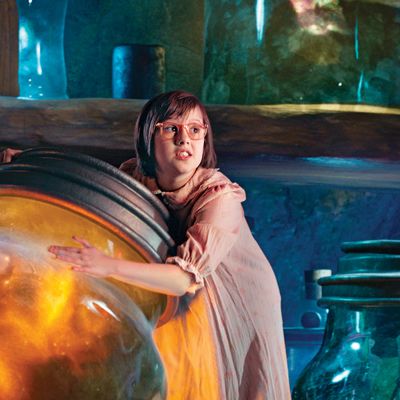
Based on the classic children’s book by Roald Dahl, Steven Spielberg’s fantasy The BFG is a labor of love that sometimes wears its love too laboriously, but a surfeit of rapture isn’t the worst thing in a movie — especially when its director has a genius for translating emotion into the rising and falling of his camera or laugh-out-loud disjunctions in scale. You shouldn’t look this big friendly giant in the mouth, especially if he has just eaten a snozzcumber.
He probably has, given that those ucky-mucky syntheses of cucumbers and snot are a major part of his diet. Unlike the big unfriendly giants who surround him, the BFG has no appetite for “human beans.” His main activity — besides cooking snozzcumbers — is fashioning dreams to be blown into the heads of children and other sleeping human beans. Before you say “How syrupy!” you should know that some of those dreams are scary and that the BFG is also given to drinking carbonated beverages in which the bubbles go down instead of up and emitting earthshaking “whiz-poppers” from his big friendly backside.
The BFG has a sublime visual running gag. In the first few moments, a cat scurries through the orphanage in which the movie’s young protagonist, Sophie (the spirited Ruby Barnhill), unhappily resides and enters the frame like a monster. But the cat is dwarfed by Sophie, who’s subsequently dwarfed by the BFG — who reaches through her window when she spies him at 3 a.m. moving through the city with his trumpets and his dreams. The BFG carries her off, bounding over buildings and into another realm, but just as we’ve adjusted to his immensity, he’s dwarfed by the enormous, nasty Fleshlumpeater, who’d regard Sophie as a rare delicacy. You wonder if there’s someone bigger yet.
Dahl wrote The BFG in the last decade of his life and said that it was his favorite of his works. Perhaps, at six-foot-six, he identified with the giant’s estrangement from humanity, or perhaps he saw himself as a cranky outcast putting dreams into children’s heads. The BFG combines his love of stretching words out like taffy with his affection for scatological humor with his abiding respect for the military (he flew perilous combat missions in World War II), which arrives in the giants’ land via helicopter at the behest of the queen, indignant over the eating of England’s children.
The BFG’s screenplay was written by Melissa Mathison, who also wrote E.T. Despite the inevitable comparisons, the two films have little in common. What made E.T. so vivid was not just the bond between a child and a being from another realm. It was E.T.’s suburban-American setting. My view is that Spielberg does better when there’s some tension between his magically fluid technique and an essentially realistic, textured world. The BFG doesn’t have that grounding, and in the film’s middle section, when Sophie and the giant fly around collecting dreams and whatnot and composer John Williams goes heavy on the airy-fairy flutes, I started to get a bit woozy-snoozy.
I could watch and listen to Mark Rylance’s BFG forever, though. Is his CG visage a little too dear for a Dahl creature? Yes, but his cracked, tender Cockney voice with its ebbs and flows is exquisite, and he all but sings those made-up words that tickle the ear and confound the spell-checker. Watching him slurp down a dozen runny fried eggs in Buckingham Palace and fart with serenity, you might think you’ve never seen such a perfect fusion of a radiant old soul and a toddler.
*This article appears in the June 27, 2016 issue of New York Magazine.


